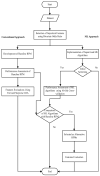Development of Nonlaboratory-Based Risk Prediction Models for Cardiovascular Diseases Using Conventional and Machine Learning Approaches
- PMID: 34886312
- PMCID: PMC8657087
- DOI: 10.3390/ijerph182312586
Development of Nonlaboratory-Based Risk Prediction Models for Cardiovascular Diseases Using Conventional and Machine Learning Approaches
Abstract
Criticism of the implementation of existing risk prediction models (RPMs) for cardiovascular diseases (CVDs) in new populations motivates researchers to develop regional models. The predominant usage of laboratory features in these RPMs is also causing reproducibility issues in low-middle-income countries (LMICs). Further, conventional logistic regression analysis (LRA) does not consider non-linear associations and interaction terms in developing these RPMs, which might oversimplify the phenomenon. This study aims to develop alternative machine learning (ML)-based RPMs that may perform better at predicting CVD status using nonlaboratory features in comparison to conventional RPMs. The data was based on a case-control study conducted at the Punjab Institute of Cardiology, Pakistan. Data from 460 subjects, aged between 30 and 76 years, with (1:1) gender-based matching, was collected. We tested various ML models to identify the best model/models considering LRA as a baseline RPM. An artificial neural network and a linear support vector machine outperformed the conventional RPM in the majority of performance matrices. The predictive accuracies of the best performed ML-based RPMs were between 80.86 and 81.09% and were found to be higher than 79.56% for the baseline RPM. The discriminating capabilities of the ML-based RPMs were also comparable to baseline RPMs. Further, ML-based RPMs identified substantially different orders of features as compared to baseline RPM. This study concludes that nonlaboratory feature-based RPMs can be a good choice for early risk assessment of CVDs in LMICs. ML-based RPMs can identify better order of features as compared to the conventional approach, which subsequently provided models with improved prognostic capabilities.
Keywords: LMICs; features importance; machine learning models; nonlaboratory-based features; risk prediction models.
Conflict of interest statement
The authors declare no conflict of interest.
Figures
References
-
- Lozano R., Naghavi M., Foreman K., Lim S., Shibuya K., Aboyans V., Abraham J., Adair T., Aggarwal R., Ahn S.Y. Global and regional mortality from 235 causes of death for 20 age groups in 1990 and 2010: A systematic analysis for the Global Burden of Disease Study 2010. Lancet. 2012;380:2095–2128. doi: 10.1016/S0140-6736(12)61728-0. - DOI - PMC - PubMed
Publication types
MeSH terms
LinkOut - more resources
Full Text Sources




